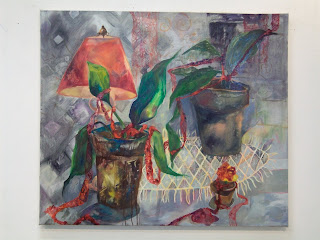
What is Painting? As artists, we ask ourselves this question because it helps us determine the central qualities of this medium. During the 20th century, artists and critics worked to discover the essence of a medium and by the middle of the century, they thought they had it (according to Jackson Pollock’s champion Clement Greenberg it was flatness). Today, we understand the qualities of a painting to be much more flexible and fluid.
If we remove the physical paint quotient, what are we left with? What are Painting’s qualities? The way it’s created? The way it appears? Its effects? We will create a “painting” without paint to test these ideas. This is an opportunity to experiment with different materials and ways of working. Delve into several ideas and select the best option. Again, any materials and supports (or lack thereof) are open to you, but the end product should express something about your understanding of “Painting”.
ConsiderBrainstorm some qualities of painting. What is the process? Visual attributes? Physical qualities? Effects?
Think of some examples that might or might not be painting. Why or why not?
What materials might be useful in creating a work that contains some of these ideas?
MaterialsAnything except traditional painting media including oil/acrylic/watercolor paint
Part 1: DesignsCome up with 5 ideas for potential ‘paintings.’ For each, describe the materials, the process for creation, and a rough sketch of the final work. This will be a part of your project grade.
Due Friday, February 20.Part II: WorkUse your initial ideas to generate a final version. It may be a combination of ideas/materials. Size, materials, etc. are up to you, but it should be something you can present or document.
Due Friday, March 13.
Look atCayce Zavaglia
This American artist abandoned traditional oil painting materials after the birth of his daughter in favor of non toxic ones. He began to use wool to create densely packed portraits. These ‘paintings’ still use the wool as a substitute for paint to create color, shape, value.
Rudolf Stingel
Stingel was born in Italy but resides and works in New York. His work explores the qualities of painting using a variety of materials and processes including interactive installation, step-by-step instructions for abstract paintings, and phlegmatic self-portraits in oil. He has an exibition opening Feb. 21 at Paula Cooper in NYC.
NY Times articlePolly Apfelbaum
Apfelbaum creates dazzling installations of fabric that she calls ‘fallen paintings’. Using dyed fabric, she creates vast organic forms that seem to spread and move over the floor.
Simon Evans
This New York based artist creates charts and maps out of snipped text and images. They are often autobiographical, absurd, and extremely literal.
Andreas Kocks
This artist uses cut paper to create wall installations. His work uses a varied and shifting sense of design that seems to spill outside of contained spaces.












 Karl Shmidt Rottluff
Karl Shmidt Rottluff

























